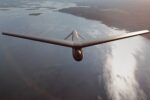The US Army has begun operational trials of the T-150 unmanned aerial vehicle (UAV) in South Korea. Designed for autonomous cargo delivery and casualty evacuation (CASEVAC), the T-150 is being evaluated as part of a broader effort to modernize battlefield logistics and reduce risk to personnel. The trials are taking place under the United States Forces Korea (USFK) command and involve real-world mission simulations in austere environments.
Overview of the T-150 VTOL Drone
The T-150 is a medium-lift vertical takeoff and landing (VTOL) UAV developed by Tactical Robotics Ltd., a subsidiary of Israel’s Urban Aeronautics. It leverages internal rotor technology based on the company’s patented Fancraft™ platform. Unlike traditional rotary-wing drones with exposed rotors, the T-150 uses ducted fans integrated into its fuselage—enhancing safety during operations near personnel or obstacles.
Key specifications of the T-150 include:
- Maximum payload: ~250 kg
- Range: up to 200 km
- Cruise speed: ~100 km/h
- Flight endurance: ~2 hours depending on load
- Autonomous flight with GPS/INS navigation
- Compact footprint suitable for confined landing zones
The aircraft is designed for modular mission payloads including supply pods, stretchers for casualty evacuation, or ISR sensors.
Operational Trials Under USFK Command
The ongoing evaluation in South Korea marks one of the first integrations of this system into a forward-deployed US military environment. According to multiple defense sources including Defense News and Janes Defence Weekly, trials began in mid-2025 at Camp Humphreys and other undisclosed locations across the Korean Peninsula.
The testing focuses on two primary mission sets:
- Tactical Resupply: Delivering ammunition, rations, water, batteries, or medical supplies to dispersed units operating beyond ground vehicle reach.
- CASEVAC: Extracting wounded personnel from contested or inaccessible terrain without risking additional lives.
The terrain complexity of South Korea—with its mountainous regions and dense urban areas—provides an ideal testbed for evaluating VTOL drones like the T-150 that require minimal landing infrastructure.
Strategic Rationale Behind Drone-Based Logistics
The US military has long sought solutions to reduce logistics vulnerabilities in peer-conflict scenarios. Traditional supply convoys are increasingly susceptible to ambushes or long-range fires. Similarly, CASEVAC by helicopter can be delayed or denied due to enemy air defenses or weather conditions.
Drones like the T-150 offer several advantages:
- Autonomy: Missions can be pre-programmed with minimal human intervention.
- Reduced Signature: Smaller radar/IR signature compared to manned helicopters.
- No Crew Risk: No pilots onboard means zero exposure during high-risk missions.
- Austere Access: Ability to land between buildings or on narrow trails enables support where helicopters cannot operate safely.
Tactical Robotics’ Role and Previous Collaborations
Tactical Robotics has previously partnered with both civilian agencies and defense forces globally. The company’s Cormorant prototype—a predecessor to the T-150—was tested by Israel’s Ministry of Defense for similar CASEVAC roles starting as early as 2019. The current model reflects lessons learned from those trials with improved avionics redundancy and simplified maintenance architecture.
The US Department of Defense has shown increasing interest in unmanned logistics platforms under programs such as Joint Tactical Autonomous Aerial Resupply System (JTAARS) and Future Vertical Lift Unmanned Aerial Systems (FVL-UAS). While not officially part of these programs yet, successful deployment of systems like the T-150 could influence procurement decisions under those frameworks post-FY2026 budget cycles.
Kinetic Implications for Indo-Pacific Operations
If proven effective during these Korean Peninsula trials, VTOL drones like the T-150 could be deployed more broadly across Indo-Pacific Command (INDOPACOM) theaters—including island-hopping logistics scenarios where traditional resupply methods are infeasible due to lack of infrastructure or contested airspace.
This aligns with recent doctrinal shifts toward distributed operations such as Expeditionary Advanced Base Operations (EABO) by the US Marine Corps or Multi-Domain Task Force concepts within US Army Pacific. Autonomous cargo UAVs could serve as critical enablers for sustaining small units operating independently across archipelagic terrain under threat from Chinese A2/AD systems.








